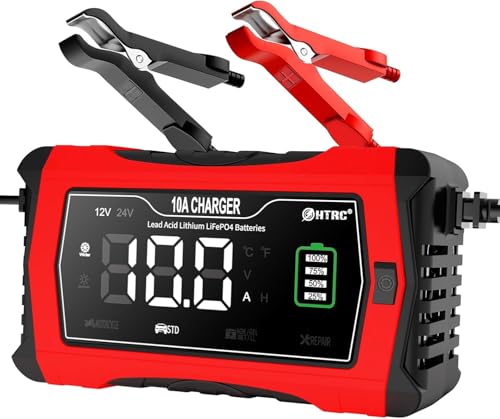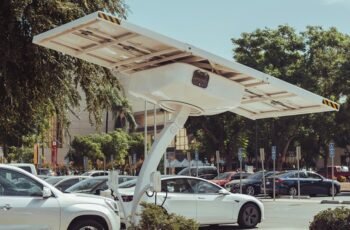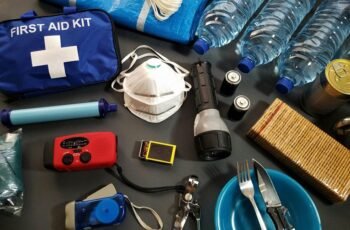Most buyers don’t realize LiFePO4 chargers can shorten battery life if they miss the correct 14.4–14.6V profile and thermal safeguards. We’ve narrowed the field to five options that balance safety, lifespan, and real-world convenience, from a rugged 10A 12V unit to a 48V golf cart upgrade with app monitoring. We’ll highlight where each excels, what to avoid, and the key specs that truly matter—so you can choose confidently without guesswork.
Key Takeaways
- BROODAY 14.6V 10A LiFePO4 charger: >90% efficient, LiFePO4-only, fast 12V charging; reports 7–10A in real use.
- NOCO GENPRO10X2: dual 10A banks, LiFePO4/AGM/lead-acid modes, IP68 marine-ready; ideal for mixed-chemistry boats.
- 10A 12V/24V smart maintainer: automatic multi-chemistry support with safety features; solid for vehicles and seasonal maintenance.
- ECO-Worthy 20A smart charger: 12V/24V auto-detect, 14.6V LiFePO4 profile and 0V activation; loud fan at high currents.
- 48V 100Ah LiFePO4 golf cart kit: 200A BMS, 58.4V/18A charger, 5000+ cycles; true drop-in high-power upgrade.
14.6V 10A LiFePO4 Battery Charger for 12V Lithium Batteries
Looking for a fast, LiFePO4-only charger that won’t cook your cells? We like BROODAY’s 14.6V 10A unit for 12V (12.8V nominal) lithium batteries. It’s not for lead-acid—strictly LiFePO4. Output is 14.6V, 10A, with >90% efficiency. It can bring a 12V 50Ah pack to 50% in about 2.5 hours, roughly twice as quick as 5A chargers.
Design is simple: durable casing, color-coded clips, LED status, and a cooling fan that doubles as a heat sink. Follow polarity, disconnect power before connecting, and you’re set. Users report 7–10A in practice. It’s compact, supported within 24 hours, and solid value.
Best For: Owners of 12V (12.8V nominal) LiFePO4 batteries who want a fast, efficient, LiFePO4-only charger with simple operation and solid value.
Pros:
- Fast charging: up to 10A output; brings a 12V 50Ah pack to ~50% in about 2.5 hours, ~2x quicker than 5A chargers
- LiFePO4-optimized 14.6V profile with >90% efficiency to enhance performance and battery life
- Easy to use: color-coded alligator clips, LED status, compact and durable build, responsive support
Cons:
- Not compatible with lead-acid batteries (LiFePO4 only)
- Real-world current may vary; some users report ~7–10A instead of a consistent 10A
- Cooling fan noise/behavior may be noticeable during operation
10-Amp 12V/24V Smart Car Battery Charger and Maintainer for Lithium, LiFePO4, and Lead-Acid Batteries
Need a versatile, set-and-forget charger that handles LiFePO4 as confidently as AGM and Gel? We like this 10-amp 12V/24V smart charger/maintainer for its fully automatic operation, memory recall, and clear backlit LCD. It supports 12V LiFePO4 and lead-acid chemistries (AGM/Gel/SLA, flooded) and 24V systems at 5A, covering cars, trucks, motorcycles, lawn gear, and boats. Temperature compensation protects against over/under charging, while multiple safeguards handle overcurrent, reverse polarity, and shorts. Repair and desulfation modes can revive some idle batteries, though not dead ones. It can’t jump-start, may feel warm, and shouldn’t use power strips. Compact metal shell, solid clamps, easy status readouts.
Best For: DIYers and vehicle owners who want a versatile, automatic 10A charger/maintainer for 12V LiFePO4 and lead-acid batteries (and 24V at 5A) across cars, motorcycles, lawn equipment, and boats, with repair/desulfation and safety features.
Pros:
- Fully automatic operation with memory recall, clear backlit LCD, and temperature compensation.
- Supports multiple chemistries (12V LiFePO4, AGM/Gel/SLA, flooded) and 24V systems at 5A.
- Built-in safety protections plus repair/desulfation modes to help revive some idle batteries.
Cons:
- Cannot jump-start vehicles; repair mode won’t fix spent or permanently damaged batteries.
- May feel warm during use and can spark briefly if connected before power-on.
- Reports of variable build quality; avoid power strips and monitor during charging.
ECO-Worthy 12V/24V 20A Smart Battery Charger Maintainer
Fast, flexible charging makes the ECO-Worthy 12V/24V 20A Smart Battery Charger Maintainer a standout for DIYers and RV owners who juggle LiFePO4 and lead-acid banks. We like its auto 12V/24V detect, selectable 5–20A output, and LiFePO4-optimized profile that reliably hits 14.6V and even wakes 0V packs. Lead-acid users get a 12V repair mode with 15V pulses to revive tired batteries.
Safety is solid: reverse polarity, short circuit, and overheat protection, plus a backlit LCD. Downsides: the fan gets loud above 5A, wires can feel warm near 20A, and meter accuracy and display timeouts draw complaints. Portable, sturdy, and fairly priced.
Best For: DIYers, RV owners, and vehicle enthusiasts who need a versatile 12V/24V charger for both LiFePO4 and lead-acid batteries with selectable 5–20A output and reliable safety features.
Pros:
- Auto 12V/24V detection with selectable 5A/10A/15A/20A (12V) and 5A/10A (24V) for flexible, faster charging
- LiFePO4-optimized profile to 14.6V with 0V activation; lead-acid repair mode with 15V pulse
- Built-in protections (reverse polarity, short circuit, overheat) and backlit LCD in a portable, sturdy design
Cons:
- Cooling fan becomes loud above 5A and runs often under higher loads
- Included wiring can feel warm near 20A; some users question wire gauge and meter accuracy
- Limited adjustability for float/voltage settings; display may time out and lacks a clear long-hold balance mode
48V 100Ah LiFePO4 Golf Cart Battery Upgrade Kit with Charger & App
If you want a true drop-in upgrade for a 48V golf cart, this 51.2V 100Ah LiFePO4 kit with a 200A Bluetooth BMS, 58.4V/18A charger, and LCD touch display delivers. We get 10.24kW max output, 200A continuous, and 600A peak for punchy hill climbs and heavier loads. The all-in-one package includes app monitoring, protections for abuse and temperature, and a mounting strap. A-grade cells promise 5000+ cycles at 80% DOD, with far lower maintenance than lead-acid. At 61.7 pounds, it fits most trays, though some carts need minor mounting or port rewiring. It’s parallel-ready (up to 4) and solar/RV friendly.
Best For: Golf cart owners and off-grid users seeking a true drop-in 48V upgrade with high power, long cycle life, built-in Bluetooth monitoring, and an included matched charger.
Pros:
- All-in-one kit: 51.2V 100Ah LiFePO4 battery, 58.4V/18A charger, 200A Bluetooth BMS, LCD display, and mounting strap—no extra accessories needed
- Strong performance: 200A continuous, 600A 3s peak (10.24 kW max) for hills, loads, and faster acceleration
- Long lifespan and low maintenance: A-grade cells rated 5000+ cycles at 80% DOD; app monitoring and protections extend reliability
Cons:
- May require minor mounting adaptations or charger port rewiring on some carts
- Heavier single-pack form factor (61.7 lb) may be cumbersome for some installations
- Parallel expansion limited to 4 units; not suitable for series connections beyond 48V systems
NOCO Genius GENPRO10X2 2-Bank 20A Waterproof Marine Battery Charger
Looking for a rugged, marine-ready charger that safely tops off LiFePO4 alongside AGM or flooded banks? We like NOCO’s Genius GENPRO10X2: a 2-bank, 20A onboard unit delivering 10A per bank at 12V. It supports lead-acid, AGM, gel, and LiFePO4, with selectable 12V, 12V AGM, 12V Lithium, and Repair modes. Each bank operates independently, ideal for mixed chemistries. An integrated thermal sensor ensures precise charging, and Force Mode can wake deeply discharged or zero-volt batteries.
It’s IP68 waterproof, smaller and more powerful than GEN2, mounts in any orientation, and shrugs off vibration. UL/ISO marine certifications, overcharge protection, a 3-year warranty, and strong user ratings seal the deal.
Best For: Boat owners or multi-battery users who need a rugged, waterproof onboard charger that can independently manage and safely charge mixed 12V chemistries including LiFePO4, AGM, flooded, and gel.
Pros:
- Two independent 10A banks support mixed chemistries with selectable 12V, 12V AGM, 12V Lithium, and Repair modes
- IP68 waterproof, vibration-resistant mounting in any orientation, with UL/ISO marine safety certifications
- Thermal-compensated precision charging plus Force Mode for deeply discharged or zero-volt batteries
Cons:
- Limited to 12V systems; not suitable for 24V/36V packs without series handling per bank
- 10A per bank may be slow for large-capacity batteries needing faster turnaround
- Higher price than basic chargers, and installation requires permanent mounting space
Factors to Consider When Choosing LiFePO4 Batteries and Chargers
As we pick the right LiFePO4 setup, we’ll match battery chemistry compatibility and voltage/current ratings to your system. We’ll balance charging speed needs with a robust safety protections suite—think BMS, over/under-voltage, short-circuit, and thermal safeguards. We’ll also check the temperature performance range so charging and discharging stay reliable in your climate.
Battery Chemistry Compatibility
Though many chargers promise “universal” support, LiFePO4 batteries need chemistry-specific charging to stay safe and last. We should match packs with chargers that explicitly offer a LiFePO4 mode and use the right algorithm. That means targeting a 12.8V nominal system with about 14.6V for charging, not the higher voltages intended for lead-acid.
We also look for LiFePO4-specific profiles that end correctly at constant voltage and apply sensible temperature compensation to avoid overcharge. Some multi-chemistry units claim compatibility yet still push unsuitable voltages—verify menus, specs, and manuals before buying.
Finally, confirm protections align with LiFePO4 behavior: overcurrent, overvoltage, short-circuit, and thermal safeguards, including low-temperature handling. Avoid Wet/Flooded or generic lead-acid profiles; mismatched algorithms cut capacity and shorten cycle life.
Voltage and Current Ratings
Why do voltage and current ratings matter so much with LiFePO4? Because LiFePO4 cells sit around 3.2–3.3V each, a 4S pack is 12.8V nominal, yet it expects about 14.4–14.6V at the top of charge for full balance. We should pair batteries with chargers that regulate within that window and respect the BMS’s recommended cutoff—often 14.2–14.6V—so we avoid overvoltage trips or incomplete charging.
Current ratings dictate safe, predictable performance. As a rule of thumb, a 10A charger fills a 50Ah pack in roughly five hours, though efficiency and taper reduce real-world speed. We also like chargers with dual-voltage (12V/24V) or balance/maintenance modes to match different configurations. Above all, match charger voltage and current to the battery’s capacity and BMS limits to prevent overcurrent, overvoltage, and thermal issues.
Charging Speed Needs
How fast do we really need to recharge, and what limits should we respect? With LiFePO4, higher charge voltage (about 14.6V) helps us reach full capacity sooner than lower-voltage profiles. But speed must match capacity. As a rule of thumb, choose smart, multi-stage chargers that deliver roughly 0.1C–0.2C. For a 100Ah pack, a 10A unit is 0.1C and cuts a 20-hour trickle to roughly 10–12 hours, depending on starting state of charge.
Real-world “fast” claims vary. A 12V 50Ah pack reaching 50% in 2.5 hours is plausible, but health, temperature, and thermal management can stretch that to 2–5 hours. We should insist on temperature compensation to maintain efficiency and keep cells within optimal limits, and avoid oversizing high-current settings that could stress the pack.
Safety Protections Suite
When we shortlist LiFePO4 gear, the safety protections suite is non‑negotiable. We look for chargers and packs that explicitly target LiFePO4 chemistry, not “universal” units tuned for lead‑acid. That avoids unsafe charge profiles.
Core protections should be spelled out: overcurrent, overvoltage, short‑circuit, reverse polarity, and overheat. These prevent damage during faults and routine use. We also want automatic shut‑off as cells near full—this eases the top‑of‑charge stress and reduces overcharge risk.
Thermal management matters. Robust designs use heat sinks or controlled fans to keep components within safe operating limits and to avert thermal runaway. Temperature compensation is another must-have; it adjusts charge parameters with ambient conditions to avoid undercharge in cold weather and overcharge in warm environments. Clear specs beat marketing buzzwords.
Temperature Performance Range
Curious about real‑world temps? LiFePO4 packs handle a broad ambient range, but charging within roughly 0°C to 45°C strikes the best balance of performance and longevity. Below freezing, internal resistance climbs, charge acceptance falls, and charging can slow or stall—so we favor systems that moderate current in the cold and avoid aggressive top‑offs.
Heat is the other constraint. Elevated temperatures speed aging and can raise safety risks during charge. We look for chargers that temper current as temps rise and keep cells comfortably below stressful thresholds. In cold climates, a steady, moderate charge current preserves capacity and cycle life; in hot conditions, we avoid charging during peak heat. Choosing gear that respects this window helps batteries deliver consistent power over many seasons.
Monitoring and Maintenance Features
Looking beyond specs, we prioritize chargers and batteries that make monitoring effortless and maintenance proactive. We want clear visibility into what’s happening, so we favor units with an LCD or crisp indicators that show voltage, current, and state of charge in real time. For 12V packs, proper support for 14.6V and an appropriate current—often 10A or higher—ensures fast yet controlled charging we can track at a glance.
Temperature compensation matters, too. It adjusts charging current based on ambient conditions to prevent over- or under-charging and extend cell life. We also value desulfation or reconditioning modes, where offered, to help older LiFePO4 packs recover optimal voltage. Finally, built-in BMS integration—or app-based dashboards—lets us monitor cell balance, voltage taps, and overall health to safeguard longevity.
Conclusion
In the end, we’re travelers choosing sturdy boots for a long trail. The 14.6V charger, smart maintainers, marine-ready NOCO, and the 48V golf cart kit are our surefooted steps—each tuned to LiFePO4’s rhythm. Voltage is our compass, thermal protection our cloak, and compatibility our well-packed map. Pick the right gear and the journey runs longer, safer, steadier. With the right battery and charger, we don’t just arrive—we enjoy the road and protect the miles ahead.







